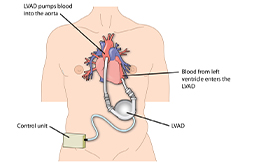
LAVD stands for Left Ventricular Assist Device which is also known as a mechanical circul0atory support device which is an implantable mechanical pump that helps the blood to pump from the lower chambers of your heart (the ventricles) to the rest of your body.
LAVD stands for Left Ventricular Assist Device which is also known as a mechanical circul0atory support device which is an implantable mechanical pump that helps the blood to pump from the lower chambers of your heart (the ventricles) to the rest of your body. A VAD is used in people who have weak hearts or have chances of heart failure. Although you can place a VAD in the left, right or maybe in both ventricles, most frequently it is used in the left ventricle. When it is placed in the left ventricle it is called a left ventricular assist device (LVAD).
Before you are admitted to the hospital for your surgery, talk to your family about your hospital stay and discuss the help that you’ll need when you will return home. Also once you get back to home your doctor and treatment team will give you instructions to follow at your home.
Food and medications
Talk to your doctor about your regular medications. Allergies or reactions that you’ve had to medications. When you should stop eating or drinking before the surgery.
Clothing and personal items
You might be recommended to bring several items to the hospital at the time of surgery, including: A list of your medications ; Eyeglasses, hearing aids or ; Personal care items, such as a brush, a comb, and a toothbrush ; Loose, comfortable clothing ; Items that help you relax, such as music players or books.
During surgery you are not supposed to wear any kind of Jewelry, Eyeglasses, Contact lenses, Dentures and Nail polish. You’ll be asked to body shave your hair where the incisions will be made. A special soap might be used on your skin to wash it to help prevent infection.
During the surgery you will be given anaesthesia so that your surgery can be performed easily. The procedure to implant a ventricular assist device (VAD) is through an open-heart surgery that generally takes four to six hours. You’ll be asleep during the surgery, so that you don’t feel any kind of pain during the surgery. You’ll be connected to a machine that will help you to breathe (ventilator) during your surgery. The doctors will put down a tube through your throat to your lungs and it will be connected to the ventilator. In this procedure, an incision is made just at the center of your chest. Then they separate your chest bone to open your rib cage so that they can operate on your heart.
You will be connected to a heart-lung bypass machine that will keep the oxygenated blood flowing through your body during the surgery if your heart stops during the surgery. Your surgical team will implant your VAD during surgery. LVAD devices have many parts. The blood is carried through a tube from the left ventricle of your heart to a pump. This pump helps the blood to deliver through another tube to the aorta and from there the artery that leads out to the body from the heart and it then delivers the blood to the body. A cable is then inserted through the skin which connects the pump to the control unit and battery pack outside your body. After your VAD is implanted and it starts working properly, your doctors will take you off the heart-lung bypass machine so that the VAD can begin pumping blood through your heart.
After your surgery is completed, you have to spend a day or more in the intensive care unit (ICU). Through intravenous (IV) lines you’ll be given fluids to eat and medications as well. The other tube will drain urine from your bladder and fluid and blood from your chest. Oxygen might be given to you through a mask or nasal prongs in your nose. After that you’ll be moved to a progressive care unit for a few days. Your treatment team will monitor your condition and watch for signs of infection in your incision sites.
Copyright © 2025 IMA | All Rights Reserved.